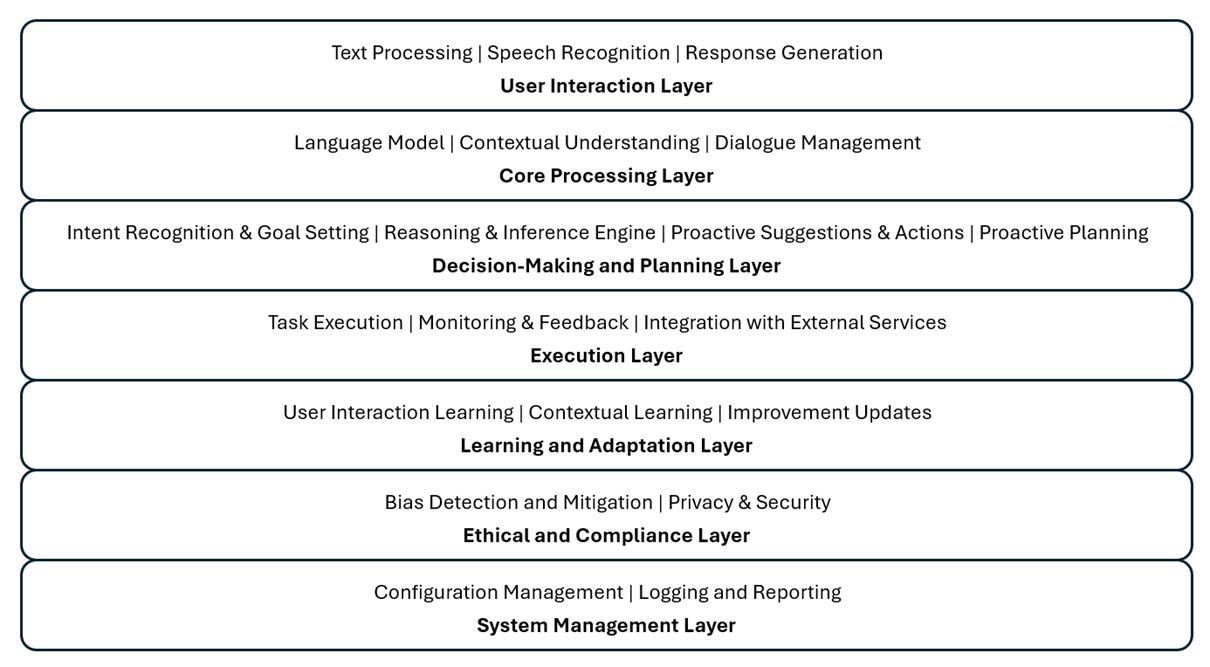Reference architecture of Agentic AI system
The reference architecture of agentic LLM-based AI systems combines various components to enable autonomy, intentionality, proactivity, decision-making, self-regulation, and continuous learning. Here is a high-level overview of such architecture:

1. User Interaction Layer
- Natural Language Processing (NLP) Interface:
- Speech Recognition: Converts spoken language into text.
- Text Processing: Handles textual input from users.
- Natural Language Generation (NLG):
- Response Generation: Produces human-like text or speech output.
2. Core Processing Layer
- Language Model:
- Contextual Understanding: Utilizes pre-trained language models (e.g., GPT-4) to understand context, intent, and user queries.
- Knowledge Base Integration: Enhances LLM with domain-specific knowledge.
- Dialogue Management:
- Context Management: Maintains conversation context across multiple interactions.
- Dialogue Flow Control: Manages the progression of conversations, ensuring logical flow and coherence.
3. Decision-Making and Planning Layer
- Intent Recognition and Goal Setting:
- Intent Detection: Identifies user intent from input.
- Goal Management: Sets and tracks goals based on user input and context.
- Reasoning and Inference Engine:
- Decision Algorithms: Applies rule-based or machine learning algorithms to make decisions.
- Inference Mechanisms: Draws logical conclusions from available data.
- Proactive Planning Module:
- Scenario Analysis: Predicts future states and plans actions accordingly.
- Proactive Suggestions: Offers proactive recommendations and actions.
4. Execution Layer
- Task Execution:
- Action Management: Manages and executes actions to fulfill user requests.
- Integration with External Services: Interfaces with APIs and external systems to perform tasks (e.g., setting reminders, fetching information).
- Monitoring and Feedback:
- Performance Monitoring: Tracks the effectiveness and efficiency of task execution.
- User Feedback Collection: Gathers user feedback for continuous improvement.
5. Learning and Adaptation Layer
- Continuous Learning Module:
- User Interaction Learning: Learns from user interactions to improve responses and actions.
- Contextual Learning: Adapts to new contexts and information dynamically.
- Feedback Loop:
- Error Analysis: Identifies and learns from errors in interactions.
- Improvement Updates: Updates models and algorithms based on feedback and new data.
6. Ethical and Compliance Layer
- Bias Detection and Mitigation:
- Fairness Algorithms: Ensures decisions and actions are fair and unbiased.
- Regular Audits: Conducts regular audits to detect and mitigate biases.
- Privacy and Security:
- Data Protection Mechanisms: Ensures user data privacy and compliance with regulations (e.g., GDPR, CCPA).
- Secure Communication: Secures data transmission and storage.
7. System Management Layer
- Configuration Management:
- System Configuration: Manages configuration settings and preferences.
- Logging and Reporting:
- Activity Logs: Maintains logs of user interactions and system actions.
- Reporting Tools: Generates reports on system performance and user interactions.
Conclusion
The reference architecture of agentic LLM-based AI systems integrates multiple layers and components to create a comprehensive, autonomous, and adaptive system. This architecture supports complex interactions, autonomous decision-making, proactive behavior, and continuous learning, all while ensuring ethical standards and user data protection.